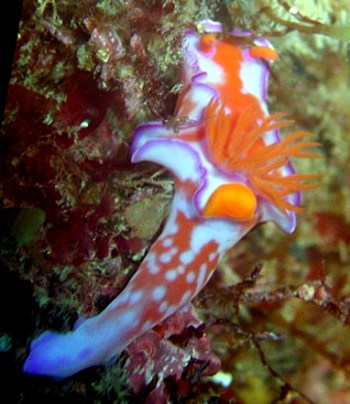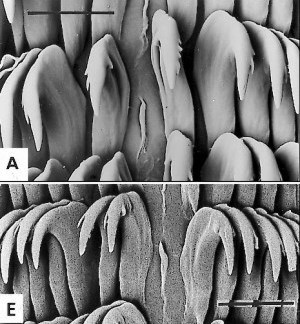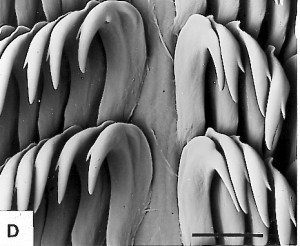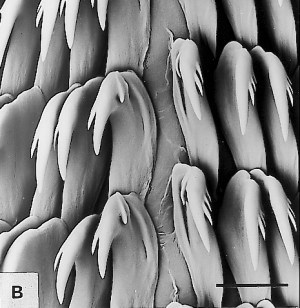
Ceratosoma bicolor
Baba, 1949
Order: NUDIBRANCHIA
Suborder: DORIDINA
Superfamily: EUDORIDOIDEA
Family: Chromodorididae
PHOTO
Yaene, Hachijo Island, Japan. Depth: 9m. 1 July 2001. Length: 50mm. Photo: Nishina Masayoshi.
Background colour ranges from white to violet-purple, with an irregular median orange band running from the gills to the from tof the head. The gills are orange. There is a reticulate pattern of orange on the posterior part of the foot behind the gills. In lighter coloured animals there is a distinct purplish submarginal band around the mantle edge, with a thin band of white at the extreme edge. In animals in which the whole body is purple, the submarginal purple border is obscured and only the thin white edge is noticeable. Baba (1949) described this species from a lighter coloured animal, and later (1989) reported on an animal which was a darker purple colour. In a revision of the genus (Rudman, 1988), I considered this to be just a colour form of Ceratosoma trilobatum as I could find no morphological or anatomical differences. There still seem to be no differences other than the distinctive colour pattern. As Baba (1989) comments, more specimens need to be studied before we can decide whether it should be considered a distinct species.
References:
• Baba, K. (1949) Opisthobranchia of Sagami Bay collected by His Majesty The Emperor of Japan. Iwanami Shoyen, Tokyo. 194pp., 50 Pls pages.
• Baba, K. (1989) Review of the genus Ceratosoma from Japan (Nudibranchia: Chromodorididae). Venus, The Japanese Journal of Malacology, 48(3): 141-149.
• Rudman, W.B. (1984) The Chromodorididae (Opisthobranchia: Mollusca) of the Indo-West Pacific: a review of the genera. Zoological Journal of the Linnean Society, 81: 115-273.
• Rudman, W.B. (1988) The Chromodorididae (Opisthobranchia: Mollusca) of the Indo-West Pacific: the genus Ceratosoma J.E. Gray. Zoological Journal of the Linnean Society, 93(2): 133-185
Rudman, W.B., 2001 (August 20) Ceratosoma bicolor Baba, 1949. [In] Sea Slug Forum. Australian Museum, Sydney. Available from http://www.seaslugforum.net/find/cerabico
Related messages
Re: Ceratosoma bicolor
August 31, 2001
From: Nishina Masayoshi


Dear Dr.Rudman,
I have just one question on your comments about Ceratosoma bicolor and Ceratosoma trilobatum. Baba mentioned there was a difference between the radular formulae of C. bicolor and C. trilobatum in Opisthobranchia of Sagami Bay.
Isn't this important sometimes? I thought that the radula formula was a good way to identify the animal. However you considered C. bicolor to be a colour form of C. trilobatum?
I am just wondering ... I will be happy if you explain this difference of radula.
Best Regards,
Nishina Masayoshi
nishina@hpe15.wips.co.jp
Nishina, M., 2001 (Aug 31) Re: Ceratosoma bicolor. [Message in] Sea Slug Forum. Australian Museum, Sydney. Available from http://www.seaslugforum.net/find/5138
Dear Nishina,
I am afraid nothing is simple. The shape of the radular teeth and their arrangement is usually a very good way of identifying which family and often which genus a species belongs to. In some cases it can also be a good way of identifying species. Unfortunately in other groups the differences between species are not so clear.
Firstly what is the radula formula? A radula is a ribbon on which there are many teeth arranged in transverse rows. Have a look at the page on the radula of Hypselodoris koumacensis for some photos of a fairly normal chromodorid radula. - In Fig A on that page, you can see a section of the leftside of the radula ribbon showing a few halfrows of teeth. The individual teeth can be differently shaped in different parts of each row. The other photos on that page show teeth from different parts of each row. The radular formula is just a count of the number of teeth in one row multiplied by the number of rows. In the case of H. koumacenisis the formula is 98.0.98 x 65 which means there are about 196 teeth in each row - 98 on each side of the midline. The 0 means that there is no tooth in the midline. The 65 records that there are about 65 rows of teeth in the ribbon.
By comparison, have a look at the page showing the radula of Flabellina poenicia. In that species there are only 3 teeth in each row, one in the centre, and one on each side. The radula formula is 1.1.1 x 12 meaning there are about 12 rows of teeth in the ribbon.
The radular formula can be a useful character but it is not the only important radular character. In species like the chromodorids, which have many teeth in each row, it is a useful way to compare the relative width of the radula ribbon in different species. However the shape of individual teeth and the relative width of the ribbon can alter during the life of an animal, so although the radular teeth can be extremely useful, it needs to be used with caution.
To illustrate this point I have included some photos of the inner radular teeth of a number of specimens of C. trilobatum. A, E, D are all adult animals, and B is a juvenile. A,E,B all show signs of a vestigial central tooth while D does not. The biggest difference is that the juvenile animal (B) has large pointed denticles, while the adults, show either little denticulation or none.
Unfortunately we know very little about C. bicolor. Baba's one specimen (approx 65mm long) had a formula of 48 x 58-65.0.65-58 which I interpret as meaning that there were between 58 and 65 teeth in each half-row. I have looked at the radula of many specimens of C. trilobatum and animal of similar size to Baba's would have a formula of about 80 x 197.0.197. So it is possible that C. bicolor is a good species which can be distinguished on colour and radular characters, but we will need to examine more material to be sure that the one specimen that Dr Baba had available to him was not damaged or aberrant.
Best wishes,
Bill Rudman
Ceratosoma bicolor? from Japan
August 22, 2001
From: Nishina Masayoshi

Dear Dr.Rudman,
I think this is Ceratosoma bicolor?
Date:1 July 2001
Location: Yaene, Hachijo Island, Japan
Depth: 9m
Length: 50mm
Frequency on Hachijo: uncommon
Best Regards,
Nishina Masayoshi
nishina@hpe15.wips.co.jp
Nishina, M., 2001 (Aug 22) Ceratosoma bicolor? from Japan. [Message in] Sea Slug Forum. Australian Museum, Sydney. Available from http://www.seaslugforum.net/find/5061Dear Nishina,
Yes this is Baba's Ceratosoma bicolor. As I discuss at the top of the page, when I revised this genus, I considered this to be a colour form of Ceratosoma trilobatum and I am still uncertain about whether it is a distinct species. Species of Ceratosoma seem to be quite variable in colour pattern so it is hard to decide whether using colour differences to define species of Ceratosoma is appropriate. One point in its favour is that I don't know of this colour form occurring anywhere but in Japanese waters. Like many nudibranch questions, I think we will have to wait until we get some more information.
Best wishes,
Bill Rudman
